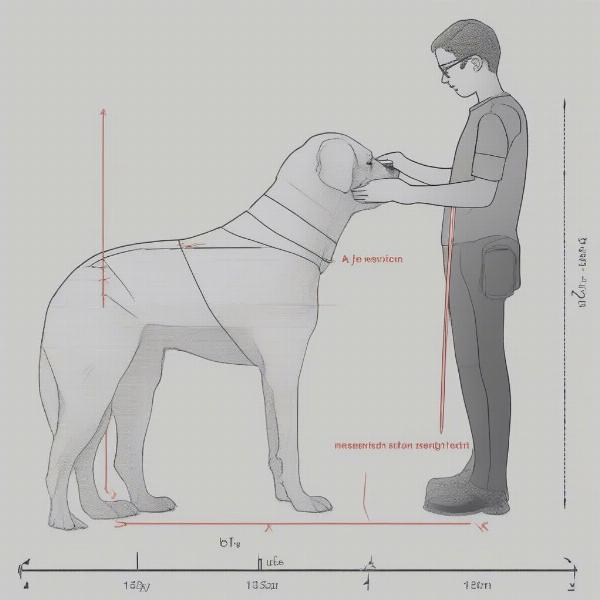Choosing the right large dog bicycle carrier can transform your cycling routine into a shared adventure with your furry friend. Finding the perfect carrier involves considering factors like your dog’s size and weight, your cycling style, and safety features. This guide delves into everything you need to know about large dog bicycle carriers, from choosing the right type to ensuring a comfortable and safe ride for your canine companion.
Types of Large Dog Bicycle Carriers
Several types of bicycle carriers cater to larger breeds. Understanding the pros and cons of each will help you make an informed decision.
- Rear-Mounted Carriers: These attach to the rear rack of your bicycle and are ideal for heavier dogs. They offer good stability and visibility.
- Trailers: Dog trailers provide a comfortable and enclosed space, perfect for longer rides or anxious dogs. They offer excellent stability but can be more cumbersome to maneuver.
- Front-Mounted Baskets: While suitable for some larger dogs, it’s crucial to ensure the basket is sturdy enough and doesn’t affect your bike’s handling.
bicycle dog carrier large dogs
Choosing the Right Size and Weight Capacity
Perhaps the most critical factor is choosing a carrier that can safely accommodate your dog’s size and weight. Always check the manufacturer’s weight limits and measure your dog to ensure a comfortable fit. A carrier that’s too small can restrict movement and cause discomfort, while one that’s too large can be unstable.
How to Measure Your Dog for a Bicycle Carrier
Measure your dog’s length from the base of the neck to the base of the tail, height from the ground to the top of the shoulders, and width at the widest point. These measurements will help you determine the appropriate carrier size.
 A dog being measured for a bicycle carrier, highlighting key measurements like length, height, and width.
A dog being measured for a bicycle carrier, highlighting key measurements like length, height, and width.
Safety First: Essential Features for Large Dog Bicycle Carriers
Prioritizing safety is paramount when cycling with your dog. Look for carriers with these key safety features:
- Secure Attachment System: Ensure the carrier attaches securely to your bicycle to prevent it from wobbling or detaching during the ride.
- Safety Straps and Harnesses: Internal straps or harnesses keep your dog securely inside the carrier, preventing falls or jumps.
- Reflective Elements: Increase visibility in low-light conditions with reflective strips or lights on the carrier.
- Ventilation: Adequate ventilation is crucial, especially during warmer weather, to prevent overheating.
Getting Your Dog Used to the Carrier
Introducing your dog to the carrier gradually is essential for a positive experience. Start by placing the carrier in a familiar area and allowing your dog to explore it at their own pace. Use positive reinforcement, such as treats and praise, to create positive associations. Gradually introduce short rides, increasing the duration as your dog becomes more comfortable.
Tips for a Smooth Transition:
- Place familiar toys and blankets inside the carrier.
- Start with short rides in a quiet area.
- Reward your dog with treats and praise throughout the ride.
Maintaining Your Large Dog Bicycle Carrier
Regular maintenance is key to ensuring the longevity and safety of your carrier. Check for wear and tear, clean it regularly, and replace any damaged parts promptly.
Conclusion
Selecting the right large dog bicycle carrier opens up a world of adventure for you and your furry friend. By considering your dog’s needs, prioritizing safety features, and introducing the carrier gradually, you can ensure enjoyable and safe cycling experiences together. Remember to choose a carrier that fits your dog comfortably and securely, and always prioritize safety.
FAQ
- How do I choose the right size bicycle carrier for my large dog? Measure your dog’s length, height, and width and compare them to the manufacturer’s size guidelines.
- What safety features should I look for in a large dog bicycle carrier? Prioritize secure attachment systems, safety straps, reflective elements, and good ventilation.
- How can I get my dog used to the bicycle carrier? Introduce the carrier gradually, use positive reinforcement, and start with short rides.
- What are the different types of large dog bicycle carriers? Rear-mounted carriers, trailers, and front-mounted baskets are common options.
- How do I maintain my large dog bicycle carrier? Regular cleaning, checking for wear and tear, and promptly replacing damaged parts are essential.
- Can I use a front-mounted basket for a large dog? It depends on the dog’s size and the basket’s sturdiness. Ensure the basket can safely support your dog’s weight and doesn’t affect your bike’s handling.
- What is the best way to secure my dog in the carrier? Use the internal safety straps or harness provided with the carrier.
ILM Dog is a leading online resource for dog owners worldwide, providing expert advice and practical tips on all aspects of dog care, from breed selection and health to training, nutrition, and grooming. We are dedicated to helping you build a strong and loving bond with your canine companion. Whether you’re a seasoned dog owner or just starting your journey, ILM Dog has the resources you need to provide the best possible care for your furry friend. For inquiries, contact us at [email protected] or call us at +44 20-3965-8624. Visit us at ILM Dog for more information.